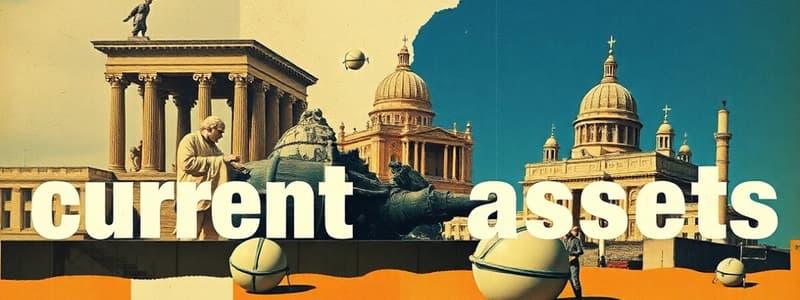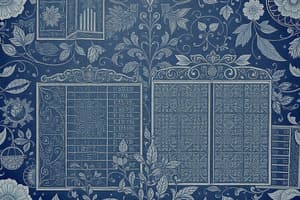Podcast
Questions and Answers
A company has $10,000 in a bank account, $5,000 in accounts receivable, $7,000 in inventory, and $3,000 in prepaid insurance. What is the total value of their current assets?
A company has $10,000 in a bank account, $5,000 in accounts receivable, $7,000 in inventory, and $3,000 in prepaid insurance. What is the total value of their current assets?
- \$15,000
- \$20,000
- \$25,000 (correct)
- \$30,000
Which of the following is the best example of an intangible asset a company might possess?
Which of the following is the best example of an intangible asset a company might possess?
- A delivery truck used to transport goods.
- Raw materials stored in a warehouse.
- A patent for a new technology. (correct)
- A building where the company's headquarters are located.
Which of the following is an example of a depreciable asset?
Which of the following is an example of a depreciable asset?
- Land purchased for future development
- The company's trademark
- Cash in a savings account
- A company-owned office building (correct)
A manufacturing company owns a warehouse, machinery used in production, and excess cash not needed for daily operations. Which of these is considered a non-operating asset?
A manufacturing company owns a warehouse, machinery used in production, and excess cash not needed for daily operations. Which of these is considered a non-operating asset?
Which of the following assets is LEAST likely to be classified as a current asset?
Which of the following assets is LEAST likely to be classified as a current asset?
A company holds stocks in another company as a long-term investment. Under which asset category would these stocks most appropriately be classified?
A company holds stocks in another company as a long-term investment. Under which asset category would these stocks most appropriately be classified?
How are trademarks classified?
How are trademarks classified?
If a company has land, equipment, and furniture, what type of assets are these?
If a company has land, equipment, and furniture, what type of assets are these?
How are machines used in factories classified?
How are machines used in factories classified?
Which of the following is considered a non-depreciable asset?
Which of the following is considered a non-depreciable asset?
Flashcards
Current Assets
Current Assets
Short-term resources converted to cash within one year. Examples include cash, accounts receivable, and inventory.
Non-Current Assets
Non-Current Assets
Long-term resources providing benefits for over a year. Examples include fixed assets, intangible assets, and long-term investments.
Tangible Assets
Tangible Assets
Physical items you can touch. Examples include land, buildings, and equipment.
Intangible Assets
Intangible Assets
Signup and view all the flashcards
Operating Assets
Operating Assets
Signup and view all the flashcards
Non-Operating Assets
Non-Operating Assets
Signup and view all the flashcards
Depreciable Assets
Depreciable Assets
Signup and view all the flashcards
Non-Depreciable Assets
Non-Depreciable Assets
Signup and view all the flashcards
PP&E
PP&E
Signup and view all the flashcards
Goodwill
Goodwill
Signup and view all the flashcards
Study Notes
- Assets are classified based on characteristics, usage, and liquidity.
Current Assets
- Short-term assets that can be converted into cash within one year.
- Include cash, cash equivalents, marketable securities, accounts receivable, inventory, prepaid expenses.
- Cash equivalents examples: bank accounts, petty cash.
- Marketable securities include stocks and bonds.
- Accounts receivable represents money owed by customers.
- Inventory includes raw materials and finished goods.
- Prepaid expenses include insurance and rent paid in advance.
Non-Current Assets
- Long-term assets providing benefits for more than one year.
- Include fixed assets, intangible assets, and long-term investments.
- Fixed assets are Property, Plant, and Equipment (PP&E) such as land, buildings, machinery, and vehicles.
- Intangible assets examples: patents, trademarks, and goodwill.
- Long-term investments include stocks, bonds, or real estate held for long-term purposes.
Tangible Assets
- Physical assets that can be touched and seen.
- Examples include land, buildings, and equipment.
- Also includes furniture.
Intangible Assets
- Non-physical assets that still have value.
- Include trademarks, brand names, copyrights, patents, goodwill, and software.
- Goodwill represents the reputation and customer loyalty of a business.
Operating vs. Non-Operating Assets
- Operating assets are used in the daily operations of a business.
- Operating assets exmaples: machinery and inventory.
- Non-operating assets are not essential to daily business operations.
- Non-operating assets examples: excess cash and investments.
Depreciable vs. Non-Depreciable Assets
- Depreciable assets lose value over time due to usage.
- Depreciable assets examples: machinery and buildings.
- Non-depreciable assets do not lose value.
- Land is a non-depreciable asset.
Studying That Suits You
Use AI to generate personalized quizzes and flashcards to suit your learning preferences.



